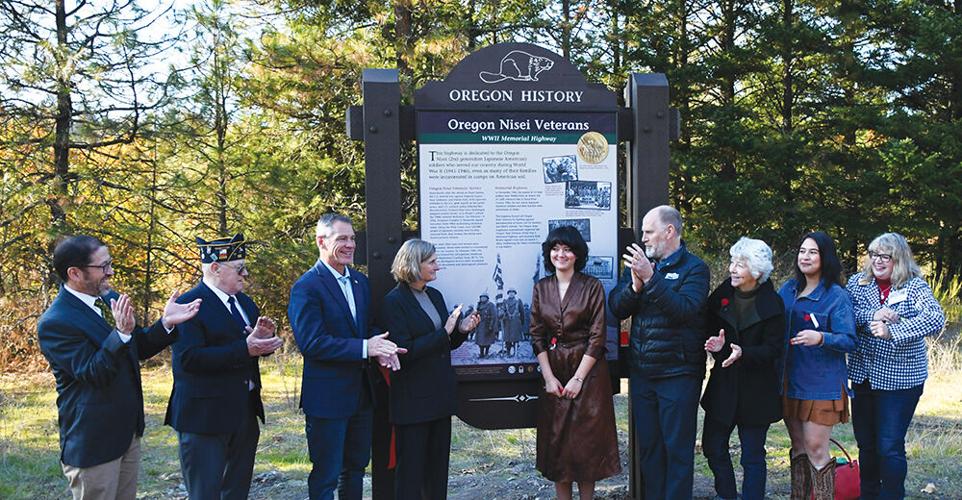Despite discrimination and internment, the second-generation Japanese Americans still fought in World War II.
By Nathan Wilson
Columbia Gorge News
HOOD RIVER — On Nov. 29, 1944, American Legion Post 22 erased the names of 16 Japanese American soldiers who fought in World War II from an honor roll list, intended to commemorate all 1,600 enlisted residents from the valley, hanging on Hood River County’s courthouse.
On Veterans Day last week, more than 80 years later, Post 22 members paid tribute to those Nisei, or second generation, soldiers by unveiling a historical marker in partnership with their descendants during a ceremony at River of Life Assembly in Hood River. Nationally, more than 33,000 Nisei and 58 from the county served in WWII despite knowing their Issei, or first-generation immigrant parents, faced internment camps and overt discrimination at home.
“Each Nisei attended local schools. Then after school, most worked with their families at their shops, hotels and on their farms. But Oregonians weren’t always welcoming,” said Linda Tamura, an author and professor whose uncle was a technical sergeant in the Army’s Military Intelligence Service. “We can rise above our past.”
“What my Issei and Nisei family endured resulted in generational trauma that still resonates today,” said Eric Ballinger, who organized the dedication with Tamura. “They served this country even when their own families lost everything and were incarcerated.”
Back in 2022, as previously reported by Columbia Gorge News, Ballinger, Tamura and Bend’s Lt. Col. Dick Tobiason successfully advocated for a bill that designated Oregon Highway 35, the 41-mile stretch between Hood River and Government Camp, as the Nisei Veterans WWII Memorial Highway. The historical marker, which recognizes the injustices against and contributions of the Nisei, now stands tall along OR 35, adjacent to the original sign and located at the first pull-off when departing from downtown.
Not wanted
While the erasure by Post 22 garnered national attention, it was one of many racist actions against Nikkei, or people of Japanese ancestry, in the valley that spanned decades prior, as Tamura explained.
Documented in one of her books, “Nisei Soldiers Break Their Silence: Coming Home to Hood River,” three-fourths of local Nikkei were farmers or orchardists by 1920, and they were finding success. By 1940, Nikkei farms contributed 25% of the valley’s production while making up a much smaller percentage of the total population, and suspicion was already virulent among their white neighbors.
Introduced by Hood River’s state Senator George Wilbur, Oregon passed an alien land bill preventing all immigrants from owning property in 1923. The same year, Oregon’s Alien Business Restriction Law enabled municipal governments to deny business licenses for immigrants and forced all immigrant business owners to display their nationality. After Japan bombed Pearl Harbor on Dec. 7, 1941, President Franklin D. Roosevelt notoriously signed Executive Order 9066, enabling the forced relocation and confinement of more than 120,000 Japanese Americans.
From January through March 1945, Legionnaire Kent Shoemaker also wrote a series of paid, full-page public notices that appeared in two local newspapers with titles like, “So Sorry Please, Japs are Not Wanted in Hood River.” Most ads included the names of 1,800 residents who supported his efforts, according to Tamura, along with lists of Nikkei landowners and their acreage so that white people would scoop up their properties.
Still, Nisei voluntarily served American interests abroad, and Ballinger highlighted the Army’s 422nd Regimental Combat Team, otherwise known as the “Purple Heart Battalion,” which is the most decorated unit for its size and length in U.S. military history. Comprised entirely of Nisei soldiers with the motto “Go for Broke,” the team earned 4,000 Purple Hearts, 4,000 Bronze Stars, 560 Silver Star Medals, 21 Medals of Honor and seven Presidential Unit Citations, according to the National WWII Museum.
During the ceremony, six fourth and fifth-generation descendants of Nisei veterans spoke, sharing the individual contributions of their relatives featured on the marker and their turmoil. Julie Whitecotton’s grandfather, Yukimori Okimoto, was in the 522nd Field Artillery Battalion that helped liberate Jewish survivors at a concentration camp in Dachau, Germany and was part of the 422nd.
“My grandfather was a man of integrity and bravery, choosing to enlist and risk his life for his country while his wife and family were incarcerated in California and Idaho,” said Whitecotton. “The pride in defending your country while simultaneously feeling the pain of the same nation’s unjust treatment of your family — American citizens — must have been difficult to reconcile.”
Moving forward
In front of living Nisei veterans, their descendants and state legislators, including former Gov. Ted Kuglongoski and Rep. Jeff Helfrich, Cmdr. Carl Casey of Post 22 acknowledged the legion’s actions and pointed toward the future.
“All veterans have earned and deserve our gratitude and respect,” said Casey. “It is with hope that we will learn from the past mistakes to ensure they are not repeated, fostering unity as citizens of this great nation.”
After the ceremony, which included traditional elements like presentation of the colors, the national anthem, a benediction and taps, a caravan of cars made the drive up Highway 35 for a ribbon-cutting. Mia Ballinger, Eric’s daughter and the great-granddaughter of Harry Morioka, did the honors as she and Eric submitted the original application to Oregon’s Travel Information Council.
“In recent years, we have come so far as a community. We now work alongside the American Legion, and we come together today to honor our veterans. We do not stay divided. We do not stay afraid of each other,” Mia said. “The highway dedication and historical marker are keeping their memory and sacrifices alive.”























Commented
Sorry, there are no recent results for popular commented articles.